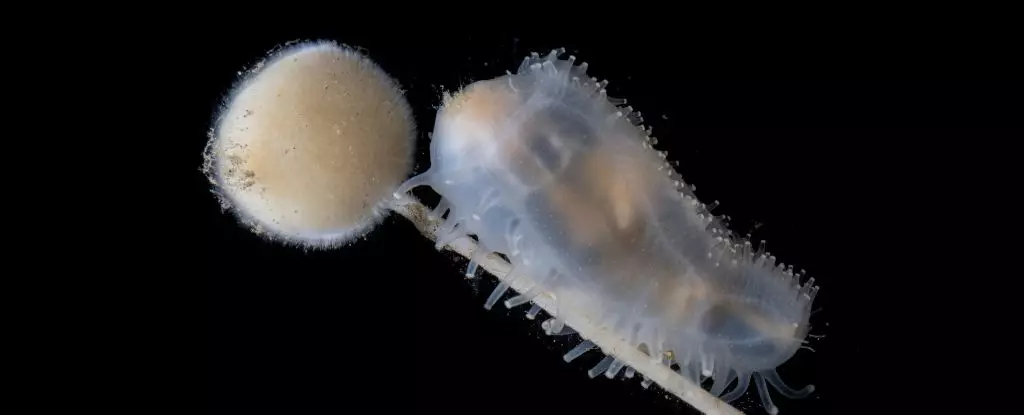The ocean, a realm representing over 70% of our planet, is often seen as a vast, unfathomable expanse. Yet, within its depths lies a treasure of biodiversity that is largely unexplored. A recent expedition to one of the world’s most secluded island chains, the South Sandwich Islands, exemplifies the untouched beauty and complexity of our marine ecosystems. Set forth by the Schmidt Ocean Institute aboard their cutting-edge vessel, Falkor (too), this 35-day voyage was not merely a scientific endeavor but a race against time to catalog marine life before it succumbs to the relentless forces of climate change and deep-sea mining.
The team of scientists emerged with breathtaking revelations, including the discovery of hydrothermal vents that had remained hidden until this very journey. These underwater geysers serve not only as portals to understanding geological processes but also as havens of extraordinary life. The sheer resilience and vibrancy of the ecosystems thriving around these vents challenge our preconceived notions of life’s adaptability and the thresholds of survival.
Hydrothermal Wonders
Among the standout highlights of the expedition was the identification of striking vermillion coral gardens nestled near Humpback Seamount, intriguingly situated above the region’s shallowest hydrothermal vents at depths of approximately 700 meters. The tallest vent chimney, reaching up to 4 meters (over 13 feet), presented an astonishing spectacle adorned with barnacles and a flurry of sea snails, akin to a bustling city skyline inhabited by myriad species. Observers were left spellbound as they witnessed shrimps zipping around the structures, reminiscent of fireworks illuminating the night sky.
This remarkable aquatic metropolis is not only captivating but serves as a crucial point for research and understanding of deep-sea biodiversity. These hydrothermal vents, explored for the first time using remotely operated vehicles (ROVs), create a unique environment teeming with life and present opportunities for gaining insights into evolutionary biology and ecosystem dynamics.
The Surprising Fauna
This expedition granted scientists a front-row seat to the unusual and often surprising marine life inhabiting these depths. One of the most stunning captures was that of an unidentified nudibranch, discovered 268 meters below the surface in icy waters. The vivid colors and unique anatomical features of such creatures challenge our understanding of adaptation in extreme environments.
Conversely, the expedition also revealed the harsh realities faced by deep-sea dwellers. A haunting image of a grenadier fish adorned with parasitic copepods nestled in its gills serves as a stark reminder of the balancing act species must perform to survive in these frigid waters. Strikingly beautiful yet unsettling, these findings prompt deeper contemplation about the intricate relationships within marine ecosystems and the impacts of environmental change.
Unveiling the Unknown
Perhaps the most thrilling moment for the team was successfully capturing an image of Akarotaxis aff. gouldae—a species of dragonfish that had eluded researchers since its identification two years ago. This achievement underscores the tremendous gaps in our knowledge of oceanic life and the potential for ongoing discoveries. Additionally, the presence of snailfish eggs on a black coral was a revelation neither marine biologists nor oceanographers had contemplated until this expedition.
Marine biologist Michelle Taylor articulated a vital point: “This expedition has given us a glimpse into one of the most remote and biologically rich parts of our ocean.” It is precisely this confluence of science, exploration, and urgency that underscores the mission of the Ocean Census—an initiative aimed at enhancing our understanding of marine biodiversity before irreversible losses occur.
A Call to Action
In a broader context, the findings from this expedition underscore an urgent call to action. As we uncover the wonders of our oceans, we also reveal the perilous fragility of their ecosystems. Our fascination with the deep sea must coincide with a commitment to its preservation. The discoveries from the South Sandwich Islands illuminate a path forward, where curiosity meets conservation. This expedition not only recorded the breathtaking beauty of marine life but also reinforced the pressing necessity for sustainable practices that protect our oceanic resources.
As we continue to explore and document our planet’s hidden treasures, let these revelations inspire action and foster a sense of stewardship—because in the heart of the ocean’s abyss lies not only the richness of our world but also a legacy for generations to come.


Leave a Reply